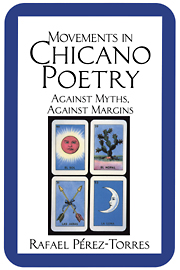Book contents
- Frontmatter
- Contents
- Acknowledgments
- 1 Introduction: Movements in a “Minority” Literature
- PART I THE POSTCOLONIAL
- 2 Four or Five Worlds: Chicano/a Literary Criticism as Postcolonial Discourse
- 3 From the Homeland to the Borderlands, the Reformation of Aztlán
- 4 Locality, Locotes, and the Politics of Displacement
- PART II THE POSTMODERN
- PART III CONFLUENCES
- Notes
- Works Cited
- Index
- CAMBRIDGE STUDIES IN AMERICAN LITERATURE AND CULTURE
4 - Locality, Locotes, and the Politics of Displacement
Published online by Cambridge University Press: 17 September 2009
- Frontmatter
- Contents
- Acknowledgments
- 1 Introduction: Movements in a “Minority” Literature
- PART I THE POSTCOLONIAL
- 2 Four or Five Worlds: Chicano/a Literary Criticism as Postcolonial Discourse
- 3 From the Homeland to the Borderlands, the Reformation of Aztlán
- 4 Locality, Locotes, and the Politics of Displacement
- PART II THE POSTMODERN
- PART III CONFLUENCES
- Notes
- Works Cited
- Index
- CAMBRIDGE STUDIES IN AMERICAN LITERATURE AND CULTURE
Summary
The tradition of the oppressed teaches us that the “state of emergency” in which we live is not the exception but the rule.
– Walter BenjaminBorn out of the dissolution of homeland represented by the borderlands, the various regions that have made up Chicana experiences in the United States must of necessity be recast if we are to treat their specificity and diversity with any accuracy and sensitivity. As is evident in the notion of “Aztlán,” the idea of land and its relationship to the notion of community has exerted a strong force on the Chicana imagination. It is clearly indisputable that before 1848 the U.S. southwest belonged to Mexico. This claim to the land, resonating as it does with the claims of Aztlán as a pre-European homeland, still informs Chicana thought. The ways of reclamation, the varied significances of “land,” change when the land ceases to be Aztlán and becomes the borderlands instead. In an age where notions like “home” and “center” come under question, Chicanas traverse a varied social and cultural terrain that places them simultaneously in numerous locales and regions. The lived practices of a people mark a literal rather than theoretical form of crossing.
This movement is both liberating and enchaining. Although it offers the possibility of living synchronically under the sway of a variety of discourses and cultural configurations, our celebration of deterritorialization cannot blind us to the fact that literal and figurative migrations also remain linked to economic and political necessity.
- Type
- Chapter
- Information
- Movements in Chicano PoetryAgainst Myths, against Margins, pp. 97 - 134Publisher: Cambridge University PressPrint publication year: 1995



